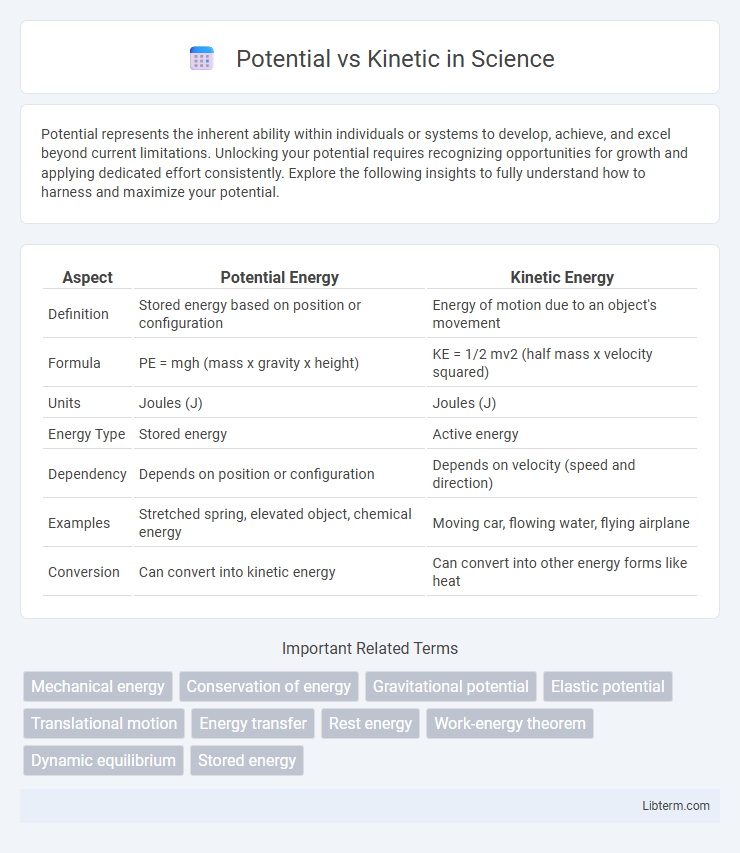Potential represents the inherent ability within individuals or systems to develop, achieve, and excel beyond current limitations. Unlocking your potential requires recognizing opportunities for growth and applying dedicated effort consistently. Explore the following insights to fully understand how to harness and maximize your potential.
Table of Comparison
| Aspect | Potential Energy | Kinetic Energy |
|---|---|---|
| Definition | Stored energy based on position or configuration | Energy of motion due to an object's movement |
| Formula | PE = mgh (mass x gravity x height) | KE = 1/2 mv2 (half mass x velocity squared) |
| Units | Joules (J) | Joules (J) |
| Energy Type | Stored energy | Active energy |
| Dependency | Depends on position or configuration | Depends on velocity (speed and direction) |
| Examples | Stretched spring, elevated object, chemical energy | Moving car, flowing water, flying airplane |
| Conversion | Can convert into kinetic energy | Can convert into other energy forms like heat |
Understanding Potential and Kinetic Energy
Potential energy is the stored energy in an object due to its position, shape, or state, commonly seen in gravitational potential energy when an object is held at a height. Kinetic energy refers to the energy of motion, which depends on the mass and velocity of a moving object, calculated by the formula KE = 1/2 mv2. Understanding the conversion between potential and kinetic energy is essential in fields like physics and engineering, demonstrating energy conservation and transfer during movement or changes in position.
Key Differences Between Potential and Kinetic Energy
Potential energy is stored energy based on an object's position or configuration, such as gravitational potential energy from height. Kinetic energy is the energy of motion, quantified by the equation KE = 1/2 mv2, where m is mass and v is velocity. The key difference lies in potential energy's dependence on position or state, whereas kinetic energy depends on the object's movement and speed.
Real-World Examples of Potential Energy
A stretched bowstring stores elastic potential energy, which converts to kinetic energy when released, propelling an arrow forward. Water held behind a dam contains gravitational potential energy, harnessed to generate electricity as it flows downward through turbines. Elevated objects like a parked car on a hill possess gravitational potential energy that transforms into kinetic energy as the car rolls downhill.
Everyday Applications of Kinetic Energy
Kinetic energy powers numerous everyday applications, from the motion of vehicles and the spinning of wind turbines to the operation of household appliances like fans and vacuum cleaners. This form of energy is harnessed during activities such as walking, cycling, and even flowing water in hydroelectric dams, converting movement into usable power. Understanding kinetic energy's role enhances efficiency in transportation, renewable energy, and mechanical systems.
The Science Behind Energy Transformation
Potential energy is stored energy based on an object's position or state, such as gravitational potential energy in a raised weight. Kinetic energy represents the energy of motion, calculated by the formula \( \frac{1}{2}mv^2 \), where \( m \) is mass and \( v \) is velocity. The transformation between potential and kinetic energy follows the principle of conservation of energy, demonstrating how energy shifts forms while total energy in an isolated system remains constant.
Factors Influencing Potential and Kinetic Energy
Potential energy depends on factors such as mass, height, and gravitational acceleration, with greater height or mass increasing stored energy. Kinetic energy is influenced by mass and velocity, where velocity has a squared effect, making speed the most critical factor. Both forms of energy are interconvertible, following the principle of conservation of energy in mechanical systems.
Conservation of Energy: From Potential to Kinetic
Potential energy stored in an object due to its position or configuration converts into kinetic energy as the object moves. The law of conservation of energy states that the total mechanical energy, the sum of potential and kinetic energy, remains constant in an isolated system without external forces. This transformation illustrates how gravitational potential energy transforms into kinetic energy, such as a rolling ball accelerating downhill.
Measuring Potential vs Kinetic Energy
Potential energy is measured by calculating the work done to position an object within a force field, typically using the formula PE = mgh for gravitational potential energy, where m is mass, g is gravitational acceleration, and h is height. Kinetic energy is quantified through the formula KE = 1/2mv2, where m represents mass and v is velocity, emphasizing the energy of motion. Precise measurements of potential and kinetic energy require accurate determination of an object's mass, height or velocity, and applicable force constants.
Potential and Kinetic Energy in Nature
Potential energy in nature represents stored energy based on an object's position or configuration, such as water held behind a dam or a rock poised on a cliff. Kinetic energy manifests when this stored energy converts into motion, evident in flowing rivers or a falling rock accelerating downward. These transformations between potential and kinetic energy drive natural phenomena like waterfalls, wind, and ocean currents, powering ecosystems and geological processes.
Practical Uses in Engineering and Technology
Potential energy powers hydraulic systems by storing energy in elevated fluids or compressed gases, enabling machinery to perform work efficiently. Kinetic energy plays a critical role in wind turbines and rotating engines, converting motion into electrical or mechanical energy. Engineers optimize these energy forms for energy storage solutions and renewable power generation, enhancing system performance and sustainability.
Potential Infographic

 libterm.com
libterm.com